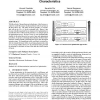285 search results - page 13 / 57 » Cell architecture for nanoelectronic design |
CF
2006
ACM
13 years 11 months ago
2006
ACM
The slowing pace of commodity microprocessor performance improvements combined with ever-increasing chip power demands has become of utmost concern to computational scientists. As...
SAC
2009
ACM
14 years 2 months ago
2009
ACM
Parallel architectures are the way of the future, but are notoriously difficult to program. In addition to the low-level constructs they often present (e.g., locks, DMA, and non-...
IPPS
2007
IEEE
14 years 1 months ago
2007
IEEE
Code compression has been applied to embedded systems to minimize the silicon area utilized for program memories, and lower the power consumption. More recently, it has become a n...
DAC
2004
ACM
14 years 8 months ago
2004
ACM
With the advent of deep-submicron technologies, it has become essential to model the impact of physical/layout effects up front in all design flows [1]. The effect of layout paras...
DAC
2006
ACM
14 years 8 months ago
2006
ACM
Modern integrated circuits require careful attention to the soft-error rate (SER) resulting from bit upsets, which are normally caused by alpha particle or neutron hits. These eve...

